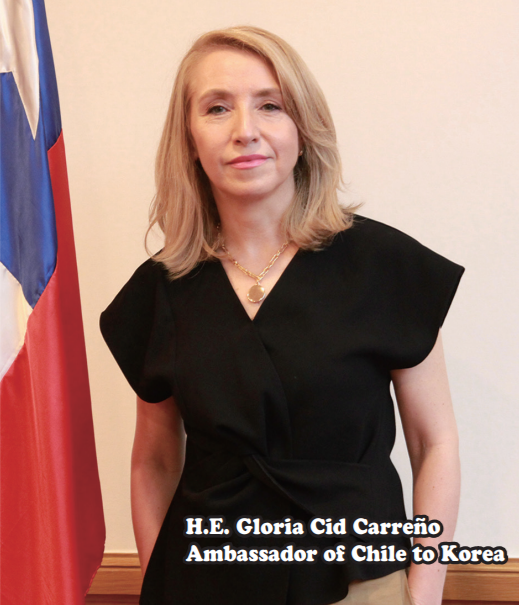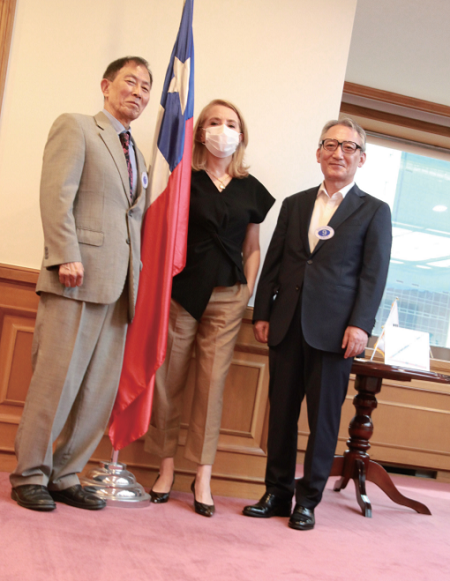
H.E. Gloria Cid Carreño is a career diplomat, graduated from the Diplomatic Academy "Andrés Bello" in 1989. She holds a degree in History from the University of Chile and has specialized in international relations, multilateral diplomacy, economic-commercial issues.
She is the first Chilean female Ambassador in South Korea.
She took office on July 1, 2020 as Ambassador of Chile to the Republic of Korea.
She was Deputy Director of the Asia Pacific Directorate (2012); Deputy Director of the International and Human Security Directorate (2018-19); and Director of North America, Central America and the Caribbean (2019-2020).
In the international arena, she has served as Head of Delegation for the SDG Negotiations (2013- 14); Head of Delegation for the Negotiations of the 2030 Agenda for Sustainable Development (2015); Coordinator of the Chilean delegation to the Summit of Heads of State and Government for the adoption of the "2030 Agenda for Sustainable Development" (2015); Head of the delegation to the High Level Political Forum (2016-2017); Head of Negotiations for the XIV Regional Conference on Women in Latin America and the Caribbean, organized by ECLAC (January 2020).
She has served at the Embassies of Chile in Costa Rica, Venezuela, Russian Federation, People's Republic of China and at the Mission of Chile to the United Nations in New York.
In commemoration of Chilean Independence Day, September 18th, the "Seoul City" magazine had an interview with H.E Gloria Cid Carreño for the Korea-Chile economic ties, present and future, Follwing are the full texts of the interview.

Please introduce the significance of your Independence Day, September 18th for our readers.
In 1810, Chile was a colony of the Kingdom of Spain. On September 18, 1810, Chile took the first step to gain its definitive independence from Spanish rule. At 9:00 a.m. on September 18, about 450 neighbors -mostly military chiefs, heads of aristocratic families and prelates of religious orders- met in the hall of honor of the Consulate building to discuss how the country should be governed after Napoleon took King Ferdinand VII captive and put his brother Joseph Bonaparte in his place.
At the Assembly, it was agreed to appoint a "Provisional Government Junta" to govern while King Ferdinand VII was imprisoned, as had already happened in other Spanish colonies in Latin America.
With the appointment of a Junta de Gobierno, the "people" of Santiago recognized and proclaimed the principle of national sovereignty. However, Chile's true independence was achieved eight years later, on February 12, 1818, when Bernardo O'Higgins signed the "Act of Oath of Independence" in the city of Talca.
Today the so-called "Fiestas Patrias" (National Festivities) are celebrated on September 18 and 19, holidays for the entire population. The festivities include four official activities: Evangelical Thanksgiving Service; Ecumenical
Te Deum; the Gala Opera and the Military Parade on September 19. Likewise, the Chilean flag is raised in all public and private venues and in Chilean embassies abroad.
Likewise, festivities take place on the part of the population, which seek to highlight the typical customs and traditions of the Chilean idiosyncrasy, with popular celebrations of national music, folklore, typical cuisine, and Chilean wine and traditional liquors. These celebrations also take place in the communities of Chileans living abroad, and in the Chilean Embassies, which carry out activities in which local authorities are invited.
Unfortunately these last two years due to the covid19 pandemic, it has not been possible to carry out these celebrations in Korea and around the world, so this year the Embassy has implemented a virtual celebration of our “Fiestas Patrias” (National Festivities).

Please elaborate the major issues discussed and agreed during summit talks held at Chong Wa Dae between Korean President, Moon Jae-in and Chilean counterpart, Sebastian Pinera on April 29th, 2019.
On September 26, 2018, the first bilateral meeting between the presidents of Chile and Korea took place in the margins of the 73rd General Assembly of the United Nations. Both, agreed to advance a thematic agenda that consists of four pillars: modernization of the State, digital economy, cyber security and cooperation in matters of climate change and global warming.
On April 28-29, 2019, President Sebastian Piñera paid a state visit to Korea, the first by a Latin American leader since Korean President Moon Jae-in took office in May 2017. The Presidential visit established a Roadmap for the bilateral relationship: Fourth Industrial Revolution, Cybersecurity, Climate Change and Digital Government.
Also, both Presidents highlighted the ongoing negotiations for the modernization of the Free Trade Agreement, which will deepen integration in bilateral trade and investment. The two leaders confirmed that this agreement, in force since 2004, has been crucial in the growth of trade between the two countries.
Likewise, President Piñera welcomed Korea's interest in joining the Pacific Alliance as an associate member and both Presidents emphasized the need to further develop the bilateral relationship and expressed their interest in deepening cooperation and exchanging experiences in areas such as infrastructure projects, information technology and communications, defense, police, Antarctica and public health.
At that time, both Presidents signing agreements and memoranda of understanding on: a) Agreement between both Governments on Cooperation in Defense Matters; b) MoU on Cooperation in the Field of Information and Communication Technologies; c) MoU on Cooperation in the Field of Transportation; and, d) MoU on Cooperation in Digital Government Matters.
Following up on the presidential visit, we’ve had two high level visits to Korea. The first one, in August 2020, with the Vice Minister of International Trade, Rodrigo Yáñez, the first high level authority from Latin America to come, in the middle of the pandemia covid19; and this year, on July 21 and 22, the Minister of Foreign Affairs, Andrés Allamand, paid an official visit to the Republic of Korea, becoming the first visit by a South American Foreign Minister to Korea since 2019.
Mr. Allamand highlighted the coincidence of deep values between Chile and Korea, such as respect for democracy, promotion of peace, attachment to freedom, as well as the importance of growth and poverty reduction, the promotion of trade integration through a system of fair and stable rules and a world order based on 78 Moon Valley, Juan Ernesto Jaeger law and multilateral organizations. He emphasized also the need to conclude this year's negotiations on the modernization of the Bilateral Trade Agreement.

Please explain investment environment of Chile for Korean potential investors and any special favors to foreign investors.
Chile is a country that stands out for having excellent conditions for foreign investors. It ranks first in rankings such as Business Environment (EIU), Best Country for Business (Forbes), Economic Freedom (Heritage Foundation) and Global Talent Competitiveness. Investments in Chile enjoy the following benefits:
- Non-discrimination: foreign companies based in Chile have the same rights and responsibilities as Chilean companies (national treatment).
- Free flow of capital and profits: Chilean legislation allows the entry and repatriation of capital without cost or restrictions other than procedural formalities.
- Business-friendly environment: simple tax structure and ease of incorporation.
- Commitment to investment promotion: government agenda in favor of investment.
The Investment Promotion Agency (Invest Chile) is Chile's official investment promotion agency. As a member country of the OECD, Chile is governed by international standards, which oblige it to follow processes such as public bidding. This ensures transparency and legal security for investments. We privilege foreign investment in the following sectors: food industry, infrastructure, tourism, energy, global services. In particular, we see great potential and synergies with Korea in the industries of renewable energies, and new energies, green hydrogen.
What do you think would be the most attractive industrial sectors for Korean companies to invest in Chile?
In November 2020, Chile launched the National Green Hydrogen Strategy, which will guide the development of this technology until 2030, offering the opportunity to private companies and governments, to invest in Chile in pilot projects. The strategy aims to have 5 GW of operating electrolysis capacity and 200 kton/ year of green hydrogen production by 2025; and 25 GW by 2030. The costs for green hydrogen production is estimated will be reduced by 2030, when it could reach USD 1.4 per kilo, the lowest price in the world. It is estimated that Korea and Japan will reach a cost of USD 2.5 per kilo in the same year.
Chile has clear comparative advantages of green hydrogen, such as: transportation costs would be the cheapest in the world; it can produce green hydrogen in the two most common ways: using electrolysis (using wind or solar renewable energies, in the north; or associated with natural gas in the south).
To this date, there are about 11 pilot projects to produce green hydrogen in Chile. Likewise, we have similar strategies in the development of H2Green, with Germany, France, Korea, Japan, Australia, Spain, Portugal, United Kingdom or states like California in the United States. Several of them consider within their strategies to import green hydrogen, which we see as an opportunity for these countries, including Korea, to invest in Chile, through technology, which would accelerate the development of the hydrogen market.
Chile and Korea remain committed to decarbonizing the economy and combating climate change. The production of socalled new energies has opened up a previously unexplored area of cooperation, what we could call "the new frontier" in the field of new energies. Chile is a privileged country in terms of quality sunlight, with a matrix that will soon reach 70% solar energy production. We cannot consume all that energy. The installation of green hydrogen production plants in the north of Chile offers great potential in the new energies sector, that can be customized for exports.
The greatest challenge in the coming years will be to displace the use of fossil fuels in the mining, transport, agriculture and industries, in order to offer products with low emissions. This only goal gives us a great opportunity to establish a solid cooperation with Korea, the tenth economy in the world, to realize concrete actions in the industry of green hydrogen. We are also looking for Korean companies to invest in green hydrogen pilot projects in Chile.
We would like to institutionalize with Korea cooperation in production, export and marketing of green hydrogen, as we have already advanced in this regard with other countries such as Singapore, Japan, Germany.

Please introduce some outstanding Korean companies' activities in Chile.
Koreacompanies has investments in Chile in sectors such as trade, mining, energy and infrastructure. The main Korean companies investing in Chile are: LG International Corp; Hyundai Engineering & Construction; Korea Resources Corporation; Daewoo; Hyundai; EAGON Industrial Co; Korea Southern Power and Samsung. Andes Green (Energy), Hanyang Chile SpA (Energy), Hanwha (Mining), and Donghaeng Corp (Food).
Also, in the construction field, POSCO Engineering & Construction (POSCO E&C) was awarded the construction for a coal-fired power plant in Chile, the Nueva Ventanas project, in 2006. It was the first Korean company to build a power generation facility in Latin America. Nowadays Posco continues to explore new investment projects in Chile.
However, increasing Korean investment in Chile is one of the major challenges in the bilateral relationship. According to ECLAC, between 2010-2018, Korean investment in Chile was only 4% of the total in the Region. Korean private companies have the capacity, the funds and the technology. We need to find the way to encourage them to invest more in Chile, through new and attractive projects in new areas, including science and technology, telecommunications, energy, electromobilty, just to name a few.
Also it is important to mention that in the beginning of the pandemic, in 2020, three major Korean companies, “Nara Cellar”, “LS Nikko Copper” and “Eagon”, made generous donations in difficult times for Chile and its people, when masks and disinfectant were not easy to find out. We appreciate very much this kind of gestures, that come from true friends of Chile.

Please introduce tourist attractions in Chile for Korean tourists abroad.
Chile is characterized by three geographical zones: the continental zone, with a length of 4,270 km, a maximum width of 445 km; the insular zone, with a group of islands of volcanic origin in the South Pacific Ocean, among which are the Juan Fernández Archipelago, the Sala and Gómez Islands, and Easter Island, in Oceania; and the Chilean Antarctic Territory, between the meridians of 53° and 90°. This territorial claim is suspended, according to the provisions of the Antarctic Treaty, to which Chile is a signatory.
Chile has one of the most diverse landscapes on the planet, which allows us to offer many options to tourists, due to our own geography. In recent years, many projects and proposals have been developed for adventure tourism and for those who love nature. This is how tourists can find a great variety of landscapes, with mountains in the Andes, beaches, temperate forests, volcanoes and coasts of different shapes, such as those found in the north, in front of the Atacama Trench; or in the south, at Cape Horn.
Likewise, there are many national parks and conservation areas, with special destinations for Koreans, who like trekking, hiking, or for cycling, rafting, and horseback riding. Also in Santiago, there are many cultural attractions, museums, galleries. And for those who want to know a unique destination, you can visit the impressive Easter Island, with the Stone Moais that guard the Island.
Recently UNESCO declared the Chinchorro mummies, the oldest deliberately man-made mummies in the world. The mummies were discovered in the coastal desert of northern Chile. The Chinchorro culture lived more than 7,000 years ago, in an area where the desert meets the Pacific Ocean and which today comprises southern Peru and northern Chile.
Some of the most iconic places are:
Torres del Paine National Park. One of Chile's most spectacular tourist attractions and one of the most popular travel destinations. More than 100 kilometers north of the city of Puerto Natales in southern Patagonia, this impressive area encompasses mountains, glaciers, and countless lakes and rivers. The most important region of the park is the Cordillera del Paine, an area that marks the transition from the Patagonian steppe to the sub-polar forests of the north.
The Valley of the Moon, located 13 kilometers west of San Pedro de Atacama in the extreme north of the country, and is one of Chile's most visited tourist attractions. This inhospitable and rugged landscape in the heart of the Atacama Desert attracts many visitors for its eerie resemblance to the surface of the moon.
Easter Island. This fascinating island with its remarkable stone sculptures is the most recognizable of Chile's tourist attractions. In total, 887 of these statues, known as Moai, created early by the island's Rapa Nui population, have been identified, most of which are now protected by the Rapa Nui National Park (the island itself has been declared a World Heritage Site). Valparaiso. Chile's third largest city, it is situated between the sea and the coastal mountain range about 112 kilometers northwest of Santiago making it an excellent day trip. As popular for its many old cobblestone streets and unique architecture as it is for its fine harbor and beaches, the city offers a wealth of things to see and do. Many tourist attractions focus on the country's rich maritime heritage, including the Lord Cochrane Museum in a beautiful colonial house built in 1842, and the excellent Naval and Maritime Museum.
Pumalín Park. A nature sanctuary since 2005, it is one of Chile's most important and popular conservation areas. Covering a vast area stretching from the Andes to the Pacific, the area has some of the most pristine coastline and forests in the country and is characterized by being almost entirely untouched by human development.

Please let us know your point of view on how to strengthen further the close economic ties between Chile and Korea in the years to come.
We must bear in mind that the greatest bilateral milestone with Korea was the signing of the Bilateral Trade Agreement in 2003, as it was the first that Chile signed with an Asian country. At the time, it was already described as a "historic agreement", distinguishing us as pioneers in trade openness, deepening our ties with the AsiaPacific. It was a fundamental step in the growth of bilateral trade and Chile's penetration in the AsiaPacific region.
The entry into force of the FTA, in 2004, granted preferential access for Chilean products and services to a market of 52 million people, and for Korea to a market of 18 million people, generating new opportunities for bilateral trade, opening a relationship of knowledge of the first Chilean products to the country, which lasts until today in emblematic noncopper products, such as wine and fruit.
The benefits of the FTA have been huge. Chile granted preferential conditions for the reexport of products manufactured in South Korea to other markets with which Chile has FTAs. In 2002, Korea paid a 7% tariff. Today, it pays a 0.2% tariff. It has also had a significant impact on greater welfare for citizens in both countries: better access to a diversity of consumer goods, food of the most varied nature, cars of practically all brands and origins; medicines and technology, greater supply of products for households and services, cell phones. More people in Korea benefits from new products and services, such as: salmon, wine, timber, fresh fruit, meat, creative industries, etc.
After Chile, Korea has intensively pursued comprehensive free trade agreements with major trading partners or regional groups (ASEAN, India, EU, Peru, USA, China), totaling 17 FTAs to date, but always continues to remember that Chile was the first.
Today Korea is Chile's third largest trading partner in Asia and the fifth largest in the world. Exports in 2020 were US$ 4,091 million, down 11% from the previous year. The main noncopper exports were: lithium (US$ 311 million); molybdenum (US$ 216 million); pork (US$ 108 million); cellulose (US$ 106 million).
Imports totaled US$ 1,010 million, a decrease of 30% with respect to the previous year. The main imports were: automobiles, other vehicles and their parts (US$ 271 million); petroleum derivatives (US$ 102 million); mechanical machinery, equipment and parts (US$ 89 million); electrical machinery, equipment and parts (US$ 81 million).
It is essential to conclude the modernization of the FTA this year, as it was agreed by both Presidents, Sebastián Piñera and President Moon Jae-in. The private sectors in both Chile and Korea have expressed their strong support for updating the FTA in the relevant areas.
It is also important to incorporate added value to the trade relationship and increase the opportunities to attract and diversify Korean investment in Chile. In recent years, new areas have appeared in international trade, such as digital trade, e-commerce, the incorporation of environmental and gender issues, trade facilitation, new energies (such as green hydrogen), intellectual property, among others. Those sectors are included in the negotiations to modernize the FTA. It is important to incorporate these sectors in our bilateral trade relationship, comprehensively, enhancing the agenda with Korea, beyond the sectors already foreseen in the FTA.
The commemoration in 2022 of the establishment of 60 years of diplomatic relations between Chile and Korea provides us with a great opportunity to reflect on our trade relations with a forward-looking perspective.
It is important to commemorate in 2022, these first 60 years since the establishment of diplomatic relations between Chile and Korea, in 1962, from a comprehensive vision of bilateral relations, seeking to deepen the traditional friendship and cooperation that have united both countries, in order to implement the Roadmap set by the Presidents in 2019. In this sense, the Embassy of Chile is preparing some activities throughout next year, that celebrate this important milestone and lay out the next 60 years.

